“The Invincibles” Arsenal 2003-04 Analysis (3) – Henry-Bergkamp Partnership
What is the traditional 4-4-2 forward pair partnership? Marziali and Mora (1997) had an argument about that in the book “Coaching the 4-4-2”. They argued that one player play as “target man” who is physically strong and good at heading. Also, he is able to play with the opposing goal at his back. The other player is rapid, quick with good individual skill, who likes starting from a distance and moving all over the attacking front. As the forward pair in the invincible team, I argued Henry-Bergkamp partnership was one of the best in Premier League history but it was not a traditional 4-4-2 forward pair partnership because of their 3 features:
Feature 1: Separation of Duties
Henry was the focal point of attack and Bergkamp had supporting role. This is supported by two evidences. Firstly, Henry scored 70% of forward players’ goal (exclude penalty) as shown in the following chart. However, it must be clarified that Arsenal was not a one-man team.
Secondly, in terms of building up goals, Bergkamp was a more efficient player than Henry which I explained last week. On the other hand, they both contributed well in terms of assist.
They were in the top 3 players in making assist. This forward partnership was so important in the team because they made 41% of team assists. If we consider the efficiency of making assist, their contribution is more obvious.
They were the top 2 most efficient assist makers in the team and Pires dropped to third. In short, Henry focused on scoring goals and making assists. Bergkamp focused on involvement of build-up of goals and making assists.
Feature 2: Different playing areas on the field
Henry played mostly at left flank and moved to central area to score goals. This argument was supported by two evidences by analysing where he scored goals and where he made assists. By considering open play goals, Henry scored 75% in central area (most inside penalty box) and 25% at left flank as shown in the following diagram.
This evidence is not strong enough so we have to analyse where he made assists as well to see where he played mostly.
Two results can be taken from this diagram. Firstly, Henry played mostly at left flank as he made 55.6% of assists on the left side comparing with 38.9% on the central area and 5.6% on the right side. Secondly, if we focus on the left side, you will realise most of his assists were made in the final 18-yard of left side (44.4% of total) while he only made 11.2% assists outside the penalty area on left side. The reason of it will be explained later in this post. Therefore, we can conclude that Henry played mostly at left flank and then drifted to centre of penalty area to score goals.
On the other hand, Bergkamp played more centrally than Henry and mostly spent his time outside the penalty area to provide support to teammates. As shown in the following diagram, Bergkamp made 70% of his assists outside the penalty area. His percentage of assists in central area and right side was more than that of Henry.
A comparative analysis could be made by making a table about where they made assists which shows their different playing areas.
| Henry | Bergkamp | |
| Final 18-yard area | 66.7% | 30% |
| Outside 18-yard area | 33.3% | 70% |
It supports my arguments above that Henry focused on playing left and scored in central penalty area while Bergkamp played more centrally and stayed outside penalty area in most of the time to provide support.
This is a video example showing their position. Even they both started on the left side, when the ball was moved to right side, Bergkamp tended to move to centre and Henry stayed at left flank until he moved to centre to score the goal in the penalty area.
Feature 3: Playing styles fit in each other
Henry was strong at attacking space behind the defence. This could be analysed by looking at the assists styles of Henry’s goals. Note that the goals from penalty and direct free kick were excluded.
Three characteristics of Henry could be seen in this chart. Firstly, Henry was a striker who didn’t rely on crossing assist (15%). In a traditional 4-4-2 system, the strikers rely on the crossing from two wingers/wide midfielders but it was not the case in the invincible team. Secondly, he was good at exploiting space behind the defence because the largest proportion of his goals (30%) was come from through ball. It fits his styles as he was a fast runner. Thirdly, technically he was good because he could score goals by dribbling past his opponent (15%) and by receiving passes to his feet (20%).
Even both players contributed well in terms of number and efficiency of making assist, their assist styles were different. This is supported by two evidences. Firstly, Henry was strong at crossing.
33% of his assists were made by crossing. It can explain why 44.4% of his total assists were made in the final 18-yard area on the left side which is mentioned above. If you consider two evidences, 66.7% of his assists were made in final 18-yard area and 55.6% of his assists were on the left side, the final 18-yard area on the left side is the overlapped area which was Henry’s key playing area.
Bergkamp was strong at providing through ball (penetrative pass to the back of defence).
The result of Bergkamp’s assist styles is more obvious than that of Henry. 40% of his assists by made by through ball. It fits the previous finding that Bergkamp tended to play outside the penalty area providing support.
The different playing styles of these two players brought out two main benefits. Firstly, they provided variety of assist styles to benefit the team based on their strengths. Secondly, Bergkamp’s assists style (through ball) fits Henry’s goal scoring style (attacking space behind the defence) perfectly. This is shown in the following video example:
In conclusion, I would like to use a table to summarise my analysis.
|
Henry |
Bergkamp |
|
| Separation of duties | Goal scoring + making assist | Build-up of goals + making assist |
| Playing areas | Left flank + final 18-yard area | More central + Outside penalty box |
| Playing styles | Attacking space behind defence + crossing | Playing through ball |
Their partnership was not a traditional 4-4-2 forward pair partnership. I argued that it was still an excellent partnership in Premier League’s history because they fitted in each other based on their strengths.
Reference:
MARZIALI, F. and V. MORA, 1997. Coaching the 4-4-2. Spring City: Reedswain
Posted on 26/01/2013, in Arsenal, Arsenal 2003/04 and tagged Arsenal 2003-04, Bergkamp, Forward partnership, Henry, Striker analysis, The Invincibles. Bookmark the permalink. 14 Comments.


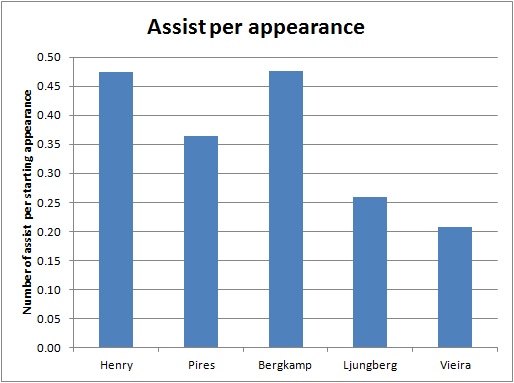

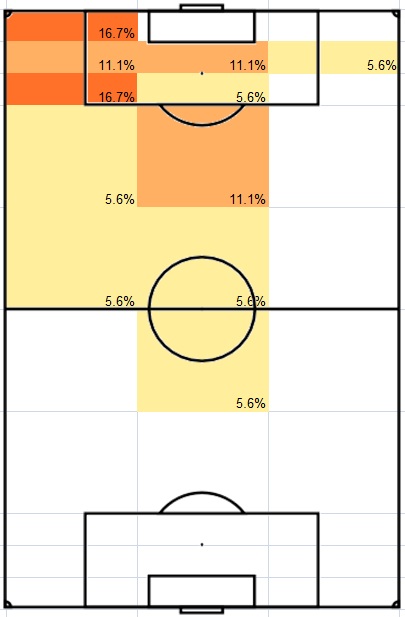

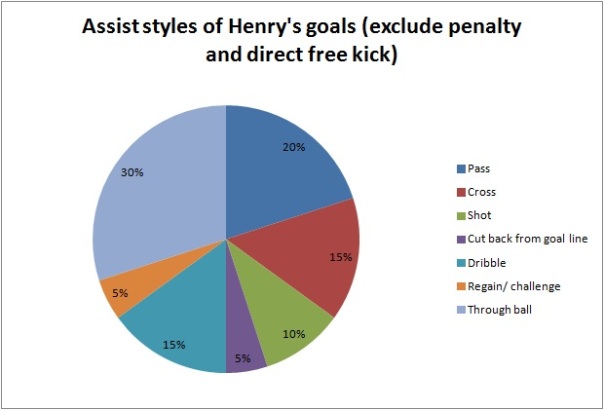
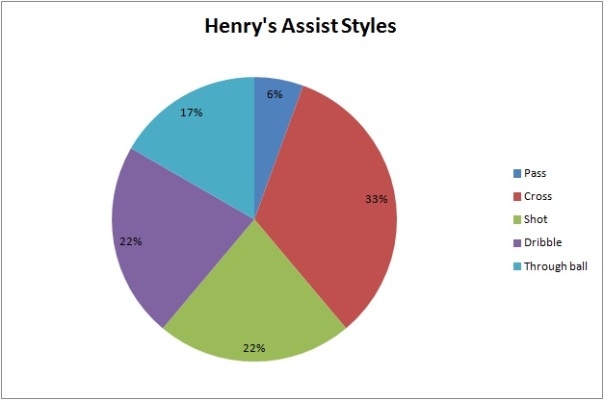
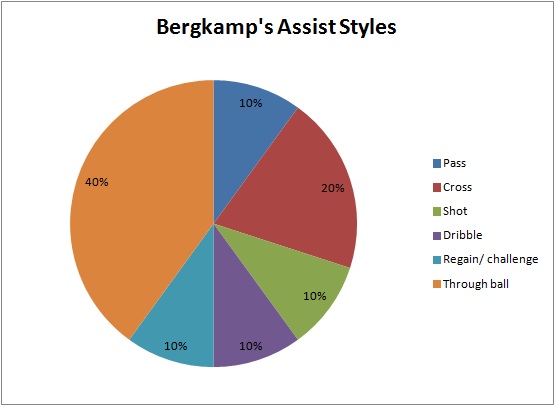

Thanks for the analysis, makes for a good read 🙂
Loved your analysis. I am someone who works with Analytics and with a keen analytical mindset about sports. If you want to partner and do more of such amazing work, please feel free get back to me on LinkedIn – Jaydeep Thakkar. I reside in Washington DC, but am originally from Mumbai and follow football and cricket a lot. Keep up the great work!
Thank you for reading my post. I have sent an invitation to you on LinkedIn
Heya! I know this is sort of off-topic but I had to ask.
Does building a well-established blog such as yours require a lot of work?
I’m brand new to operating a blog however I do write in my diary every day. I’d
like to start a blog so I can easily share my own experience and
feelings online. Please let me know if you have any ideas or tips for new aspiring blog owners.
Thankyou!
Hi, thank you for your comment (even though it is a little bit off-topic, haha). If you are new to operating a blog, I would suggest you to start with “blogger” or “wordpress”. When I started, I can’t differentiate which is better so I used both. After running a blog for almost a year, I would recommend “wordpress” more because of various reasons. By using wordpress.com, there are so many themes for you to choose from so that I can focus more on writing the posts. Hope it helps.
Hi, there is a great analysis. I really enjoy it!
One question, do you know where can I download matches of the “Invencibles”? I searched all over the web and I didn´t find anything … I hope that you know!
Unfortunately, there is no way to find on the web. What I did was I ordered a 49 unbeaten games DVD from Amazon.
Hi, there is a great analysis. I really enjoy it!
One question, do you know where can I download matches of the “Invencibles”? I searched all over the web and I didn´t find anything … I hope that you know!
Unfortunately, there is no way to find on the web. What I did was I ordered a 49 unbeaten games DVD from Amazon.
Hi! This was a great read! Where did you find the data to write features 2 and 3. Did you have access to archived match footage or something like it, or did you use an external website like Opta?
Pingback: “The Invincibles” Arsenal 2003-04 Analysis (4) – Henry, Pires and Cole | Football Performance Analysis
Pingback: “The Invincibles” Arsenal 2003-04 Analysis (1) – Squad and formation | Football Performance Analysis
Pingback: RECREATING THE ARSENAL INVINCIBLES – THE INTRO | SI Sports Centre
Pingback: Arsenal Invincibles - Part One - Tea & Busquets